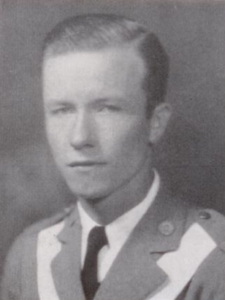Scroll of Honor – Forrest Hugh Coleman, Jr.
Too Young to be Old
To most of us, 33 doesn’t seem very old. But, when you’re surrounded by young men in their late teens and early 20s, your perspective might change a bit. Forrest Hugh Coleman, Jr. of Laurens found himself in just this situation when he was called to active duty in November 1942.
and early 20s, your perspective might change a bit. Forrest Hugh Coleman, Jr. of Laurens found himself in just this situation when he was called to active duty in November 1942.
Coleman enrolled in Clemson College just as the Great Depression began to squeeze the momentum from the United States economy. A member of the Class of 1933, Coleman was selected as the Best Drilled Cadet during his sophomore year of 1930. Coleman was an electrical engineering major and served as vice president of the Laurens County Club, was a member of the Sabre Club and attended ROTC training at Fort McClellan, Alabama.
Coleman married the former Caroline Burroughs of Augusta, Georgia. They were the parents of a daughter, Sue, and son, Forrest Hugh III.
In October 1940, the United States implemented its first peace-time draft. Draftees were called to federal service for a twelve month term to undergo basic military training. Fearful of the international situation, President Roosevelt in the summer of 1941 asked Congress to extend the draftees’ tours of duty beyond twelve months. After the United States entered World War II, a new Selective Service Act made men between 18 and 45 eligible for military service and required all men between the ages of 18 and 65 to register.
By April 1942, the Army was inducting young men at the rate of almost 150,000 a month. The supply of 1-A men, those deemed “available for military service,” from the 1940 registration was running out. Local draft boards began eying slightly older registrants. Coleman, when called to duty in November, had already passed his 33rd birthday, making him senior to most of the men with whom he would soon be serving.
Coleman was assigned to the 3rd Infantry Division which in August of 1944, two months after the D-Day invasion in Normandy, would land across the beaches of southern France as part of General Alexander Patch’s 7th Army. By September 11, 7th Army had linked up with Patton’s 3rd Army, and it seemed as if the war was nearly over. The 3rd Infantry Division reached the Rhine River on November 26, but was ordered to dig in and hold the position due to logistical restraints. Having reached the very border of Hitler’s Third Reich, Coleman was killed in action three days later.
First Lieutenant Coleman was survived by his wife, two children and his sister. In 1948, his body was returned to the United States. He was interred at Westview Memorial Park in Laurens. He is also memorialized on the Laurens War Memorial.
For additional information about Forrest Hugh Coleman, Jr. see:
https://soh.alumni.clemson.edu/scroll/forrest-hugh-coleman-jr/
For more information about Clemson University’s Scroll of Honor visit:
https://soh.alumni.clemson.edu/scroll-of-honor/
